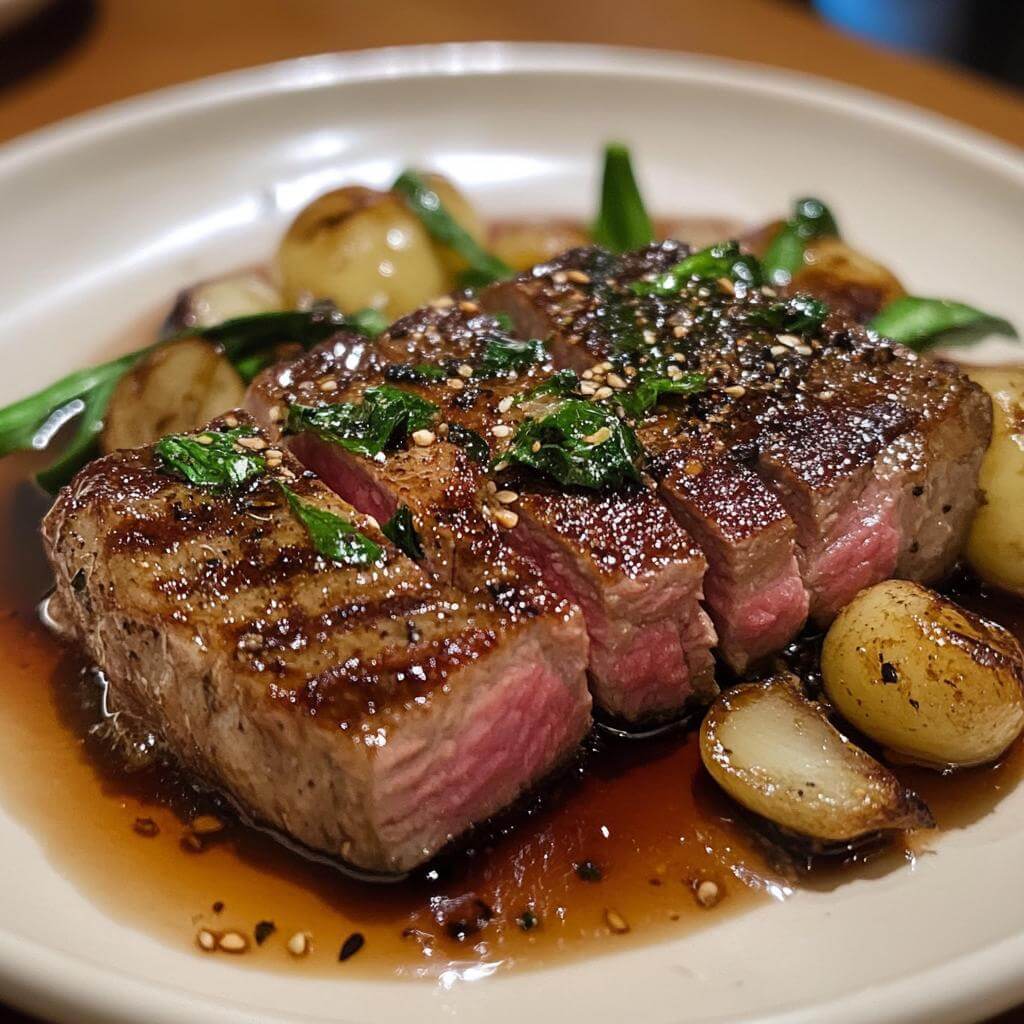Save This Recipe
What Is the Red Juice in a Rare Steak?
If you love a good steak (and goodness knows I do), there’s nothing quite as tempting as a juicy, deeply red piece of beef fresh off the grill. But let’s be honest—some folks get downright squeamish at the sight of red liquid pooling on their plate. Over the years, I’ve heard more than a few friends push their steak aside, convinced they’re looking at a puddle of blood and that rare steak is somehow risky business.
Here’s the truth: that red stuff is definitely not blood. Nope, not even close! What you’re seeing is actually a mix of water and a protein called myoglobin—totally natural, totally delicious, and, dare I say, responsible for quite a bit of what makes a steak taste downright magical. Let’s dig into what this “juice” really is, why it’s nothing to worry about, and exactly how it makes steak so irresistible.
Understanding Meat Composition
Let’s start with the basics. What’s inside that steak, anyway? Well, most of it is—believe it or not—water. Here’s what’s going on beneath the surface:
- Water: Makes up about 75% of the meat’s weight. That’s what gives you all that beautiful juiciness (and why overcooked meat is so sad and dry).
- Protein: This includes myoglobin, plus other proteins that help create structure and texture in the meat. These are what give you that satisfying “bite.”
- Fat: Where you get flavor, richness, and, let’s be honest, a little bit of indulgence. Don’t skip the fat cap—that’s where the magic lives!
When you cook meat, all three elements change. Myoglobin, in particular, is the culprit behind that red color—and it’s the same thing giving your steak its handsome looks and mouthwatering juice.
What Is Myoglobin and Why Is It Red?
Let’s talk about myoglobin (and don’t worry, there won’t be a quiz at the end). Myoglobin is a protein found specifically in muscle tissue. Its job? To store oxygen for the muscles when they’re at work. Think of it as the steak’s own little oxygen locker.
It’s a close cousin to hemoglobin—the stuff in our blood that carries oxygen all around our bodies. Here’s the interesting bit: myoglobin picks up oxygen and binds it to a teeny iron atom, which gives the protein its telltale red color.
Fun fact for your next steak dinner: red meats (think beef and lamb) are packed with myoglobin, making them bright and vibrant, while white meats (like chicken and turkey) are much paler with only a little myoglobin tucked away in their tissues. Now you know why a rare beefsteak looks entirely different than a rare piece of chicken (and why the latter should probably stay on the grill a little longer—for safety’s sake!).
Why the Red Juice Isn’t Blood
I’ve lost track of how many times I’ve heard someone say the juice from their steak is “bloody.” Honestly, if there’s one kitchen myth I could clear up forever, this might be it! When beef is processed after slaughter, almost all the blood is removed right away. What’s left is firmly in the muscle tissue.
The liquid you see in your steak? It’s mostly water and myoglobin (not blood), pooling from the natural fibers as the steak cooks and then rests. Myoglobin, just like blood, has iron—which explains why the juice is so red and easy to mistake for blood if you don’t know the science. But truly, there’s nothing scary about it. It’s just the natural, flavorful dewiness that comes from a properly cooked cut of meat (and if you ask me, it’s something to be celebrated, not feared).
How Myoglobin Changes During Cooking
Now, here’s where things start to get a bit more “science-y,” but in the best possible way. The color and juiciness of your steak are all about how that myoglobin reacts to heat. So, depending on how long you cook, things start to shift:
- Raw Meat: The myoglobin is at its most vibrant—a deep red, almost purplish color, which is why raw beef is so dark.
- Rare to Medium-Rare (120-130°F): As you gently heat the steak, myoglobin starts to release water, and you get that signature rosy-red juice oozing out when you cut in. This is why rare steak is so juicy and almost glistens on the plate.
- Medium to Well-Done (140°F+): When the heat goes up, the iron in myoglobin oxidizes—that’s science-speak for “myoglobin goes from red to brown.” That’s why a well-done steak isn’t pink or red at all, but more grayish-brown and, let’s face it, a little less exciting if you’re a steak lover.
That red juice you see in a rare steak? It’s just water that’s still clinging to myoglobin, giving you that lush color and juicy bite. Overcooking means all that loveliness gets dried up or cooked away (and as much as I love a charred edge, nobody wants a hockey puck, right?).
Why Red Meat Contains More Myoglobin
If you’ve ever noticed that beef and lamb are much redder than chicken, you’re not imagining it. It’s all about myoglobin levels. Here’s a cheat-sheet for your next grocery run:
- Beef: Loads of myoglobin, which is why it’s so richly colored. So satisfying!
- Lamb: Also packed with myoglobin, though just a bit less than beef.
- Pork: Technically considered “red meat” (I know, everyone says “the other white meat”), but it has lower myoglobin, which gives pork its pale pink look when cooked.
- Chicken: The real lightweight of the group—chicken breast in particular has almost no myoglobin, so it stays whitish when cooked.
This is exactly why you might crave a rare steak but would never consider eating rare chicken or pork (let’s not, for the love of safety). Chicken especially should always be thoroughly cooked, but beef—oh, beef was just made to be pink and juicy.
Is the Red Juice in a Rare Steak Safe to Eat?
Absolutely! That reddish juice is your steak’s way of telling you it’s at peak tenderness and flavor—it’s not just safe, but downright delicious. It’s loaded with nutrients (shout-out to iron, which we can all use), and myoglobin itself helps carry a little nutrient “cargo” from the muscle.
So unless you have a rare (hah) medical reason to avoid red meat, that rosy juice is nothing but good news for your taste buds. There’s not an ounce of danger in it—the only risk is falling a bit too in love with the perfect medium-rare. (I mean, we all have our weaknesses!)
Tips for Cooking the Perfect Steak
Want to wow your dinner table, or maybe just treat yourself to a cozy night in? Here’s what I’ve learned after more steaks than I’d care to admit:
- Pick the Right Cut: Go for ribeye, sirloin, or filet mignon if you want a truly juicy, flavorsome experience. They’re higher in fat and myoglobin and practically made for indulgence.
- Mind That Temperature: Invest in a meat thermometer (seriously, life-changing) to get your steak exactly how you like it:
- Rare: 120-130°F (49-54°C)
- Medium-Rare: 130-135°F (54-57°C)
- Medium: 135-145°F (57-63°C)
Keep in mind it’ll rise a smidge as it rests, so don’t be afraid to pull it off just a little early.
- Let It Rest: This is the step that’s oh-so-tempting to skip—but really, let your steak rest for at least 5-10 minutes (cover with foil, pour yourself a glass of wine). This gives the juices time to redistribute, so every single bite is as tender and lovely as the next. I’ve rushed it before, and regret always follows—ask me how I know.
- Don’t Overcook: It’s easy to panic and leave the steak an extra few minutes “just to be safe.” But overcooking is the surest way to dry things out and lose all that wonderful juice. Trust your thermometer and resist the urge!
Debunking the Myth Once and for All
If you hear someone fretting about “bloody steaks” at your next cookout, now you’re armed with the facts. That red drip is simply water mingling with good old myoglobin—nothing alarming, just nature doing its job.
So, order your steak with confidence—rare, medium, or (if you must) well-done. You can appreciate each bite not only for its flavor but for the fascinating science that makes steak so irresistibly juicy. Trust me, understanding myoglobin makes that first mouthful even better.
Final Thoughts
There’s something so satisfying about slicing into a perfectly cooked steak and watching those juices flow. It’s not blood, friends—it’s the result of meat cooked just right, full of flavor, and rich in nutrients. Knowing what myoglobin is (and how it responds to heat) lets you savor every bite even more.
So tuck in, enjoy your favorite cut with confidence, and if anyone ever asks about the “red stuff” in their steak, you can just smile and say: it’s not blood—it’s pure, flavorful perfection.

